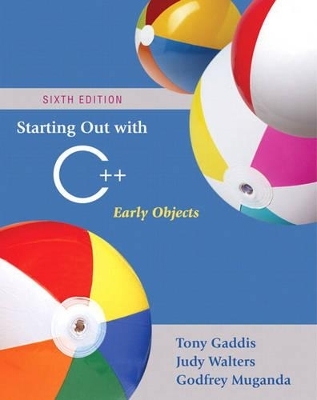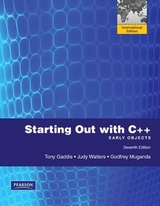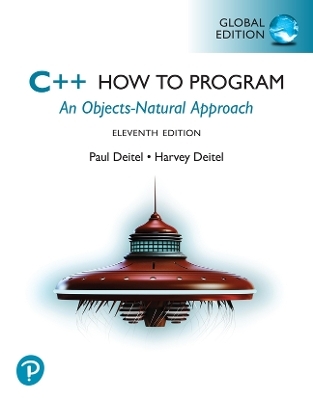
Starting Out with C++
Pearson
978-0-321-51238-3 (ISBN)
- Titel erscheint in neuer Auflage
- Artikel merken
In Starting Out with C++: Early Objects, Gaddis covers objects and classes early after functions and before arrays and pointers. As with all Gaddis texts, clear and easy-to-read code listings, concise and practical real-world examples, and an abundance of exercises appear in every chapter. This text is intended for either a one-semester accelerated introductory course or a traditional two-semester sequence covering C++ programming.
Tony Gaddis is the principal author of the Starting Out with series of textbooks. Tony teaches computer science courses at Haywood Community College in North Carolina. He is a highly acclaimed instructor who was previously selected as the North Carolina Community College "Teacher of the Year,” and has received the Teaching Excellence award from the National Institute for Staff and Organizational Development. Besides C++ books, the “Starting Out with” series includes introductory books using the Java™ programming language, Microsoft® Visual Basic® .NET, and Microsoft® C#®, all published by Addison-Wesley. Judy Walters is an Associate Professor of Computer Science at North Central College in Naperville, Illinois. In addition to her many computer science courses, she enjoys teaching a freshman course on film and literature. She also enjoys studying foreign languages and cultures, and recently developed a new course in technology and society, which she taught in Costa Rica Fall 2005, as part of the college's international studies program. Godfrey Muganda is an Associate Professor of Computer Science at North Central College in Naperville, Illinois, where he chairs the Computer Science Department. He teaches a wide variety of courses at both the undergraduate and graduate levels including courses in Object-Oriented Programming, Comparative Programming Languages, and Complier Design. His primary research interests are in the Fuzzy Sets and Systems. He won the North Central College faculty award for outstanding scholarship in 1993.
Chapter 1 Introduction to Computers and Programming
1.1 Why Program?
1.2 Computer Systems: Hardware and Software
1.3 Programs and Programming Languages
1.4 What Is a Program Made of?
1.5 Input, Processing, and Output
1.6 The Programming Process
1.7 Procedural and Object-Oriented Programming
1.8 Case Studies
Chapter2 Introduction to C++
2.1 The Parts of a C++ Program
2.2 The cout Object
2.3 The #include Directive
2.4 Standard and Prestandard C++
2.5 Variables, Constants, and the Assignment Statement
2.6 Identifiers
2.7 Integer Data Types
2.8 The char Data Type
2.9 The C++ string Class
2.10 Floating-Point Data Types
2.11 The bool Data Type
2.12 Determining the Size of a Data Type
2.13 More on Variable Assignments and Initialization
2.14 Scope
2.15 Arithmetic Operators
2.16 Comments
2.17 Focus on Software Engineering: Programming Style
2.18 Case Studies
Chapter3 Expressions and Interactivity
3.1 The cin Object
3.2 Mathematical Expressions
3.3 Implicit Type Conversion
3.4 Explicit Type Conversion
3.5 Overflow and Underflow
3.6 Named Constants
3.7 Multiple and Combined Assignment
3.8 Formatting Output
3.9 Working with Characters and String Objects
3.10 Using C-Strings
3.11 More Mathematical Library Functions
3.12 Introduction to Files
3.13 Focus on Object-Oriented Programming: Member Functions
3.14 Focus on Debugging: Hand Tracing a Program
3.15 Green Fields Landscaping Case Study—Part 1
Chapter4 Making Decisions
4.1 Relational Operators
4.2 The if Statement
4.3 The if/else Statement
4.4 The if/else if Statement
4.5 Menus
4.6 Nested if Statements
4.7 Logical Operators
4.8 Validating User Input
4.9 More About Variable Definitions and Scope
4.10 Comparing Characters and Strings
4.11 The Conditional Operator
4.12 The switch Statement
4.13 Enumerated Data Types
4.14 Testing for File Open Errors
4.15 Focus on Testing and Debugging: Validating Output Results
4.16 Green Fields Landscaping Case Study—Part 2
4.17 Additional Case Studies
Chapter5 Looping
5.1 The Increment and Decrement Operators
5.2 Introduction to Loops: The while Loop
5.3 Using the while Loop for Input Validation
5.4 Counters
5.5 The do-while Loop
5.6 The for Loop
5.7 Keeping a Running Total
5.8 Sentinels
5.9 Using a Loop to Read Data From a File
5.10 Focus on Software Engineering: Deciding Which Loop to Use
5.11 Nested Loops
5.12 Breaking Out of a Loop
5.13 The continue Statement
5.14 Focus on Testing and Debugging: Creating Good Test Data
5.15 Central Mountain Credit Union Case Study
5.16 Additional Case Studies
Chapter6 Functions
6.1 Modular Programming
6.2 Defining and Calling Functions
6.3 Function Prototypes
6.4 Sending Data into a Function
6.5 Passing Data by Value
6.6 The return Statement
6.7 Returning a Value from a Function
6.8 Returning a Boolean Value
6.9 Using Functions in a Menu-Driven Program
6.10 Local and Global Variables
6.11 Static Local Variables
6.12 Default Arguments
6.13 Using Reference Variables as Parameters
6.14 Overloading Functions
6.15 The exit() Function
6.16 Stubs and Drivers
6.17 Case Study: Little Lotto
6.18 Additional Case Studies
Chapter7 Introduction to Classes and Objects
7.1 Combining Data into Structures
7.2 Accessing Structure Members
7.3 Initializing a Structure
7.4 Nested Structures
7.5 Structures as Function Arguments
7.6 Returning a Structure from a Function
7.7 Unions
7.8 Abstract Data Types
7.9 Object-Oriented Programming
7.10 Introduction to Classes
7.11 Introduction to Objects
7.12 Defining Member Functions
7.13 Focus on Software Engineering: Separating Class Specification from Implementation
7.14 Using a Constructor with a Class
7.15 Overloading Constructors
7.16 Destructors
7.17 Input Validation Objects
7.18 Using Private Member Functions
7.19 Home Software Company OOP Case Study
7.20 Introduction to Object-Oriented Analysis
7.21 Focus on Object-Oriented Design: Finding the Classes and their Responsibilities
7.22 Additional Case Studies
Chapter8 Arrays
8.1 Arrays Hold Multiple Values
8.2 Accessing Array Elements
8.3 Inputting and Displaying Array Contents
8.4 Array Initialization
8.5 Processing Array Contents
8.6 Using Parallel Arrays
8.7 The typedef Statement
8.8 Arrays as Function Arguments
8.9 Two-Dimensional Arrays
8.10 Arrays with Three or More Dimensions
8.11 Vectors
8.12 National Commerce Bank Case Study
8.13 Arrays of Structures
8.14 Arrays of Class Objects
8.15 Additional Case Studies
Chapter 9 Searching, Sorting, and Algorithm Analysis
9.1 Introduction to Search Algorithms
9.2 Searching an Array of Objects or Structures
9.3 Introduction to Sorting Algorithms
9.4 Sorting an Array of Objects or Structures
9.5 Sorting and Searching Vectors
9.6 Introduction to Analysis of Algorithms
9.7 Case Studies
Chapter10 Pointers
10.1 Pointers and the Address Operator
10.2 Pointer Variables
10.3 The Relationship Between Arrays and Pointers
10.4 Pointer Arithmetic
10.5 Initializing Pointers
10.6 Comparing Pointers
10.7 Pointers as Function Parameters
10.8 Focus on Software Engineering: Dynamic Memory Allocation
10.9 Focus on Software Engineering: Returning Pointers from Functions
10.10 Pointers to Structures and Class Objects
10.11 Focus on Software Engineering: Selecting Members of Objects
10.12 United Cause Relief Agency Case Study
10.13 Additional Case Studies
Chapter11 More About Classes and Object-Oriented Programming
11.1 The this Pointer and Constant Member Functions
11.2 Static Members
11.3 Friends of Classes
11.4 Memberwise Assignment
11.5 Copy Constructors
11.6 Operator Overloading
11.7 Type Conversion Operators
11.8 Convert Constructors
11.9 Object Composition
11.10 Inheritance
11.11 Protected Members and Class Access
11.12 Constructors, Destructors, and Inheritance
11.13 Overriding Base Class Functions
11.14 Case Studies
Chapter12 More About Characters, Strings, and the string Class
12.1 C-strings
12.2 Library Functions for Working with C-Strings
12.3 String/Numeric Conversion Functions
12.4 Character Testing
12.5 Character Case Conversion
12.6 Writing Your Own C-String Handling Functions
12.7 More About the C++ string Class
12.8 Creating Your Own String Class
12.9 Advanced Software Enterprises Case Study
12.10 Additional Case Studies
Chapter13 Advanced File and I/O Operations
13.1 Files
13.2 Output Formatting
13.3 Passing File Stream Objects to Functions
13.4 More Detailed Error Testing
13.5 Member Functions for Reading and Writing Files
13.6 Working with Multiple Files
13.7 Binary Files
13.8 Creating Records with Structures
13.9 Random-Access Files
13.10 Opening a File for Both Input and Output
13.11 Online Friendship Connections Case Study: Object Serialization
13.12 Additional Case Studies
Chapter14 Recursion
14.1 Introduction to Recursion
14.2 The Recursive Factorial Function
14.3 The Recursive gcd Function
14.4 Solving Recursively Defined Problems
14.5 A Recursive Binary Search Function
14.6 Focus on Problem Solving and Program Design: The QuickSort Algorithm
14.7 Recursion Example: The Towers of Hanol
14.8 Focus on Problem Solving: Exhaustive and Enumeration Algorithms
14.9 Focus on Software Engineering: Recursion Versus Iteration
14.10 Case Studies
Chapter15 Polymorphism, Virtual Functions, and Multiple Inheritance
15.1 Type Compatibility in Inheritance Hierarchies
15.2 Polymorphism and Virtual Member Functions
15.3 Abstract Base Classes and Pure Virtual Functions
15.4 Multiple and Virtual Inheritance
15.5 Focus on Object-Oriented Programming: Composition Versus Inheritance
15.6 Secure Encryption Systems, Inc. Case Study
Chapter16 Exceptions, Templates, and the Standard Template Library (STL)
16.1 Exceptions
16.2 Function Templates
16.3 Class Templates
16.4 Class Templates and Inheritance
16.5 Introduction to the Standard Template Library
16.6 Case Studies
Chapter17 Linked Lists
17.1 Introduction to the Linked List ADT
17.2 Linked List Operations
17.3 A Linked List Template
17.4 Recursive Linked List Operations
17.5 Variations of the Linked List
17.6 The STL list Container
17.7 Reliable Software Systems, Inc. Case Study
17.8 Additional Case Studies
Chapter18 Stacks and Queues
18.1 Introduction to the Stack ADT
18.2 Dynamic Stacks
18.3 The STL stack Container
18.4 Introduction to the Queue ADT
18.5 Dynamic Queues
18.6 The STL deque and queue Containers
18.7 Focus on Problem Solving and Program Design: Eliminating Recursion
Chapter19 Binary Trees
19.1 Definition and Applications of Binary Trees
19.2 Binary Search Tree Operations
19.3 Template Considerations for Binary Search Trees
19.4 Case Studies
Appendix A The ASCII Character Set
Appendix B Operator Precedence and Associativity
Index
Appendices on the accompanying student CD:
Appendix C An Object-Oriented System Development Primer
Appendix D Using UML in Class Design
Appendix E Namespaces
Appendix F Passing Command Line Arguments
Appendix G Header File and Library Function Reference
Appendix H Binary Numbers and Bitwise Operations
Appendix I C++ Casts and Run-Time Type Identification
Appendix J Multi-Source File Programs
Appendix K Introduction to Microsoft Visual C++ 2005
Appendix L Introduction to Borland C++ Builder 6.0
Appendix M Introduction to Microsoft Visual C++ 2003
Appendix N .NET and Managed C++
Appendix O Introduction to Flowcharting
Appendix P Answers to Checkpoints
Appendix Q Answers to Odd-Numbered Review Questions
| Erscheint lt. Verlag | 28.8.2007 |
|---|---|
| Sprache | englisch |
| Maße | 206 x 251 mm |
| Gewicht | 1998 g |
| Themenwelt | Mathematik / Informatik ► Informatik ► Programmiersprachen / -werkzeuge |
| ISBN-10 | 0-321-51238-3 / 0321512383 |
| ISBN-13 | 978-0-321-51238-3 / 9780321512383 |
| Zustand | Neuware |
| Informationen gemäß Produktsicherheitsverordnung (GPSR) | |
| Haben Sie eine Frage zum Produkt? |
aus dem Bereich

